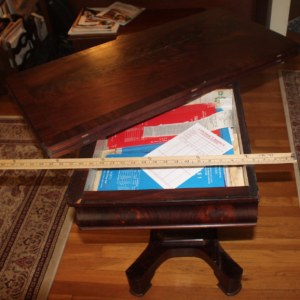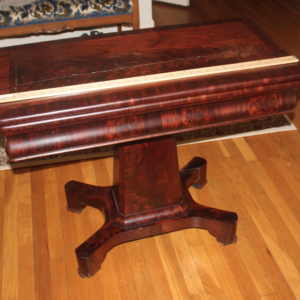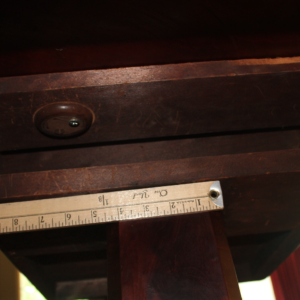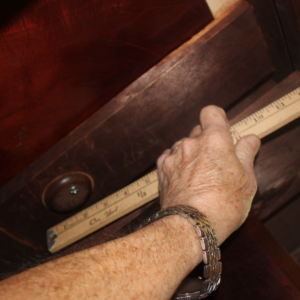I would like to build a version of a very interesting game table I saw recently. It’s pretty old, probably at least 50 years old, but I don’t know much more than that. When open it has approximately a 38″ square top with a center post support. The top folds in half and turns 90 degrees and the table becomes a side table, half the size of the open version, with a 3″ deep compartment under most of the closed top and the same base as the center support. What I can’t figure out is the exact mechanism of the round post structure (approximately 2.5″ in diameter) on which the top turns. I won’t try to take the one I’ve seen apart, of course, but I would like some advice on how to construct this important mechanism. Thanks in advance. -Steve
I’ve attached four photos, two from above and two from underneath to show the exposed part of the post.



















Replies
Send photos!
I'm trying to get a grip on how the table opens. Is it correct to assume that the top is centered on the base in both side-table and game-table configurations?
If you have access to it, send a photo of the table both open and closed with a coin directly over the pivot point... in theory when you pivot the tabletop with the coin on it the coin will not move.
I've worked out how it could work with a straight groove on the underside of the top. Perhaps a metal plate with a narrower slot traps a pin on which the top pivots. I'll make a sketch and an animation to show it.
Let's see if this works.
This is the top turned over. The pin with the head might be a bolt or lag screw. Might need a block or something on the inside of the end apron to attach to.
Here's an animation showing the top sliding and swiveling. The line on the top shows the centerline of the groove on the underside. I've omitted the other half of the top for clarity.
https://flic.kr/p/2jtTNtx
@DaveRichards: I was thinking of a slide, but his OP said there was a 2.5" post that the top turns on. VERY cool animation BTW!
It could be a bigger post than I've modeled or it might be a cylinder with a smaller headed pin between it and the table top.
Thanks. The animation was fairly simple once I figured out what has to happen with the top.
Thanks for all your feedback. I really like the animation, but there's no sliding going on with this table when it turns to open. I've attached a few more photos, so there are two from the top and two from the bottom. In the latter two you can see the part of the post that's exposed. I can't tell from looking at it whether the diameter of the entire post is this big (about 2.5") or whether I'm just looking at a wooden cap and the inside post is a lot thinner. There are two screws in bottom of the post, one that blends in too well to see in the the pictures and one that was added more recently (and a little off kilter). That suggests to me that what you can see here is just a wooden cap. The table is 17" by 34" closed. To find the pivot axis, look straight down at the top of the table in the closed position (long direction vertical), then start at the center of the table and go 4 1/4" to the left and 4 1/4" down.
Pretty cool, I'm going to play with some cardboard tomorrow.
If there's only a pivot around the axis as you describe, the top wouldn't be way off center when it is open. This is an animation that shows pivot only around the point based on the dimensions you gave. (I guessed at the size of the box underneath.
https://flic.kr/p/2juxtD5
If you move the pivot closer to the middle of the long side, though, I think it would work. This next animation was made after just eyeballing the pivot.
https://flic.kr/p/2juz5Tc
It would be easy enough to figure out exactly where the pivot has to be.
Nice! My old-school cardboard was about the same.
Turn a stepped dowel (think toilet paper dowel w/o the spring) and fasten the upper step (tenon) into a flat board to screw to the underside of the top. The distance to the lower step should be the depth of the box. The lower tenon should be as thick as the base of the box and would be secured with the cap from below.
Wider shoulders at the bottom will make the function more stable.
I'm not sure I described the pivot point well enough. I'll try again. Looking down on the top, the closed table is 17" wide and 34" tall. A different way to describe the situation is that the pivot point is 4 1/4" to the left of the vertical center line and 4 1/4" below the horizontal center line. I like your animation and appreciate your making it, but the pivot doesn't seem to be in the right place. Thanks very much for your interest.
If you are looking for measured plans hire someone to draw them. You have an oft-published expert trying to help you. IMHO he deserves better than a somewhat dismissive "thanks for you interest" and further instruction. Rant over.
I apologize if I offended anyone. I am certainly not looking for measured drawings at all, just suggestions on what the pivot is and how it works. My "thanks for your interest" was not meant to be dismissive, but quite genuine. I AM thankful for his interest and suggestions. With my "further instruction" I was merely trying to clarify what might have been inadequate earlier descriptions on my part.
To Dave: again, thank you.
Fair enough.
Dave, I overlooked your second animation. Thanks for spending time using my first description to nail the table! It's looks just like the real thing. I appreciate your thoughtfulness.
FWW #165 Page 38
https://www.finewoodworking.com/2006/12/01/an-expandable-table
If it were me - and I'm not saying you should do this - I would take it apart until I could go no further or I figured out how it works. I have no problem undoing things that were done well. It taught me how locks work, how typewriters work, how carburetors work...
You got two screws. I'd start there. Unscrew 'em and see what comes apart. Maybe the table lifts off and you can get a better view. If you see another screw, keep going!
Of course you're getting this advice from someone who puts back together a typewriter and discovers, among other parts that never made it back into the typewriter; a ball bearing, and metal stick that is bent in a decidedly intentional way. Yet the typewriter works!*
*Except for the letter "m" which goes 95% of the way to the ribbon, then comes to an invisible wall. But really, who needs an "m" that uch?
This forum post is now archived. Commenting has been disabled